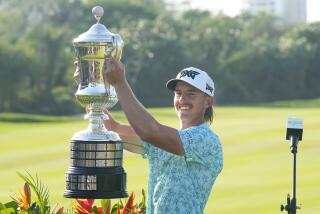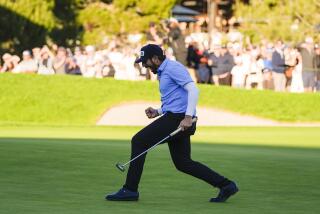77TH PGA CHAMPIONSHIP: RIVIERA : Right on Course : Team Pavin Couldn’t Be in a Better Place as Corey Goes for Another Major
- Share via
One day in 1964, when Corey Pavin was 3, Barbara Pavin lined up her three sons in the living room of their home in Oxnard. It was time for a little chat.
“I told them: ‘Look, there’s only one of me and three of you, so pick the same sport,’ ” Mrs. Pavin said. “They all did.”
Matthew, Fletcher and Corey Pavin all picked golf, which meant that Barbara Pavin eventually would spend most of her summers driving to junior tournaments in the family Oldsmobile station wagon, the one that Jack Pavin fitted with a mattress in the back so the boys could snooze.
The three Pavins took to golf like duck hooks to water, especially Corey, the youngest, who three decades later would win the U.S. Open and put himself in the driver’s seat heading into a major championship for the first time in his life.
When the PGA Championship begins Thursday at Riviera, the only thing more certain than John Daly’s barber being out of work is that the player voted most likely to succeed will be none other than Corey Pavin.
Now, who could have expected that?
John Fiedler is the head pro at Las Posas Country Club in Camarillo, where Pavin learned the game on a lush, rolling course laid out with eucalyptus, pine and willow trees.
Fieldler, who has known Pavin for close to 20 years, was interviewed about Pavin recently.
The conversation went something like this:
Question: Did you ever think Corey would be so good?
Answer: Not really, I thought he was too short.
Q: But there have been a lot of good short golfers.
A: I mean short off the tee.
Oh. Sorry. Pavin might stand only 5 feet 9, but that shouldn’t be the big height issue. After all, how tall is the pile when you stack up the $5.9 million that Pavin, 35, has won on the PGA Tour?
Then start putting his 13 victories on top of each other. How tall is that?
Well, better take another look at it. The Pavin legacy continues growing, even if Pavin himself isn’t.
In fact, Pavin has a chance to join the company of none other than Ben Hogan at Riviera this week. It was Hogan who won the 1947 L.A. Open at Riviera, won it again in 1948, then won the U.S. Open at Riviera that summer.
Add it up and that’s two regular tournament titles and a major title on the same course in a two-year span. Pavin, who won the Nissan L.A. Open in 1994 and ‘95, can equal Hogan with a victory in the PGA Championship. And he is the favorite.
Pavin, only a little reluctantly, is prepared to be the center of attention this week.
“I’m going to try not to pay that much attention to it, really,” he said. “Sure, I feel comfortable at Riviera, a place where I’ve won. But I’ve learned what other people say or write is just not that important. It’s what I’m feeling.
“What I have to do is be prepared, play one shot at a time and see what happens. How other people look at me really has no bearing on how I will do. I don’t get my perspective from what other people say.”
So what forms the Pavin Perspective? As it turns out, it’s a team thing.
THE BRAIN COACH AND SWING DOCTOR
Coop and Cook . . . no, it’s not a fried chicken franchise.
Pavin entrusts his mental approach to sports psychologist Dick Coop of Chapel Hill, N.C., and his swing to teacher Chuck Cook of Austin, Tex.
Coop, an educational psychologist at the University of North Carolina, has the job this week of not letting Pavin get run over in the expectation derby.
“How Corey handles that will determine his week,” Cook said.
Coop and Cook are basically a unit. They go together like flag and stick. They were with Pavin most recently during the British Open at St. Andrews, where Pavin tied for eighth.
Cook, who teaches at Barton Creek Lakeside near Austin, said Pavin is so independent about his golf game that the help Cook offers is more about fine-tuning than reshaping.
Tom Kite is also a client of Cook’s but requires an entirely different approach. Kite wants to know every inch of his golf swing, wants it on videotape and wants to know exactly where he is, Cook said.
Not Pavin, whom Cook described this way: “He is a player not trapped by structure.”
The Pavin swing philosophy is simple, Cook said. If it feels good, do it.
“Even if it’s a real ugly-looking shot, he’s not concerned how the ball gets to the hole, only whether it does or not,” Cook said.
A British Open case in point: Payne Stewart was paired with Pavin and they came to the tee at No. 17, the Road Hole. Stewart smoked a high, beautiful drive over the H in the Old Course Hotel sign.
Then it was Pavin’s turn.
“He hit a running slice, wrapped about the sheds, landed short and then ran about 30 yards past Payne,” Cook said.
“Some players are wrapped up a lot in technique, how to hit the ball, really more interested in their swing and the flight of the ball. Corey just gets it there.
“He hits the ball so low, if you give him a place where the ball can run, he’s going to be above average in length.”
Carry distance is Pavin’s only weakness, said Cook, who is working with Pavin to try to help him draw the ball better.
And make no mistake about it, as sure as a barranca is a ditch, Riviera sets up well for Pavin.
“It’s definitely a slicer’s golf course, a cutter’s golf course,” Cook said. “It fits right into his hands.”
THE AGENT
What price success? For the new U.S. Open champion, it’s as much as $350,000 for an overseas appearance.
Rocky Hambric of Cornerstone Sports, which represents Pavin, said the golfer will probably play in five or six foreign events by the end of the year.
Pavin could play more, a lot more, but there’s less chance of that happening than Hugh Grant cruising down Sunset in a convertible any time soon.
“You’ve got to take some time off,” Hambric said. “You can’t play every week.”
Check out Pavin’s schedule:
--In late August and early September, he will play in the Suntory Open in Japan and the European Masters.
--He has a charity appearance in Orlando, Fla., the Volvo Asian Masters in Taipei in October and the Grand Slam of Golf in mid-November.
--He has invitations to play in Hawaii, on the mainland and in Japan the first week of November, and in the third week of November, he has been invited to play in Hong Kong.
--Around Thanksgiving, he has been invited to play in the Australian Open.
--He is also invited to the Sun City Million Dollar challenge the last of November in South Africa and to the Johnnie Walker in Jamaica in mid-December.
Other than that, he has absolutely nothing to do. Chances are he can fill time counting his money, if he so desires.
Pavin endorses Cleveland golf clubs, Cross Creek clothing, Titleist golf balls, Footjoy shoes and Rolex watches, deals that probably earn more than $1 million annually.
Hambric said Pavin is uncomfortable talking about the money business.
“Corey won’t chase the dollars as much as a lot of other guys will,” he said. “He’s pretty much wrapped up in the competitive aspect.”
Hambric also represents Larry Nelson, Bob Tway, Larry Mize, Scott Simpson and Hal Sutton, all major winners like Pavin.
“But I’ve never seen anyone stay so focused on what they are doing the rest of the year and the rest of their career as Corey has,” Hambric said.
“Corey looks upon winning a major as not his major championship, but his first major championship.”
THE CLUB MAKER
When Kite saw Pavin’s cavity-backed irons for the first time, he said they looked like garden tools.
“Tom’s beautiful,” Pavin said. “The next time he saw them, he said ‘Garden tools? Heck, I wouldn’t even use them in my garden.’ ”
Nevertheless, Roger Cleveland said his business is up 10% because of Pavin’s success with the VAS irons and metal woods.
Pavin usually doesn’t play when he is at home in Orlando, which means the clubs hit the corner of the garage pretty quickly.
It was Cleveland who persuaded Pavin to try the new irons nearly two years ago. Pavin has won three times since.
“There aren’t too many guys on tour on a par with him,” Cleveland said.
Pavin made the four-wood famous with his approach shot to the 18th green on the last day at Shinnecock Hills, where he won the U.S. Open.
Cleveland said Pavin is carrying more than 14 clubs in his bag this week.
“He’s got such huge pressure,” Cleveland said. “He’s learning how to handle that. He’s got a lot on his mind this week.”
The mind is sometimes a dangerous place, but most agree it’s Pavin’s strength. Determined, as concentrated as a can of frozen orange juice, focused--that’s Pavin.
Bruce Hamilton, who coached Pavin for 19 years at Las Posas until they agreed to part ways early this year, said what sets Pavin apart is simple.
“It’s his will to win,” said Hamilton, a teaching pro at Los Robles in Thousand Oaks. “He wanted a major for so long. All his mechanics were right, it was just a matter of putting it all together.”
Since it all came together, Pavin’s victory at Shinnecock has had a trickle-down effect, even on his parents.
Jack Pavin, retired from the retail shoe business, is finding it easier to come up with sponsors for Corey’s charity tournament in February at Las Posas.
Barbara Pavin has noticed a change too. More people are asking her for signed photographs of Corey. Oh, and one more thing.
“It’s easier for me to get a golf game now,” she said.
This week, Jack and Barbara will be watching their son take on Riviera, hoping for the best and probably wondering how it came to this after summers in the Oldsmobile with the mattress in the back.
“We weren’t out to raise a golf pro,” Jack Pavin said.
It just turned out that way.
More to Read
Go beyond the scoreboard
Get the latest on L.A.'s teams in the daily Sports Report newsletter.
You may occasionally receive promotional content from the Los Angeles Times.










